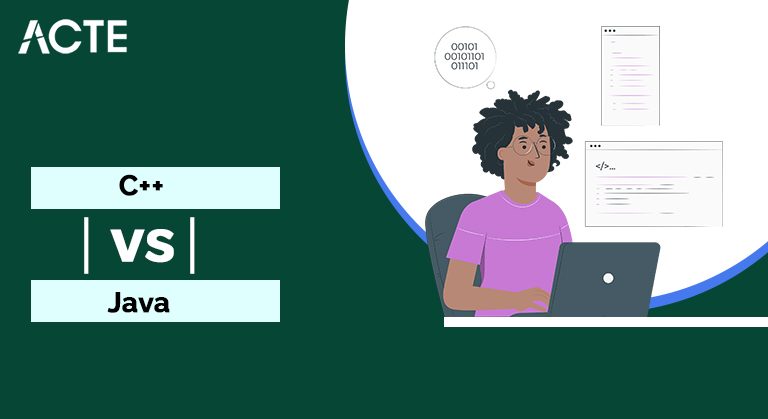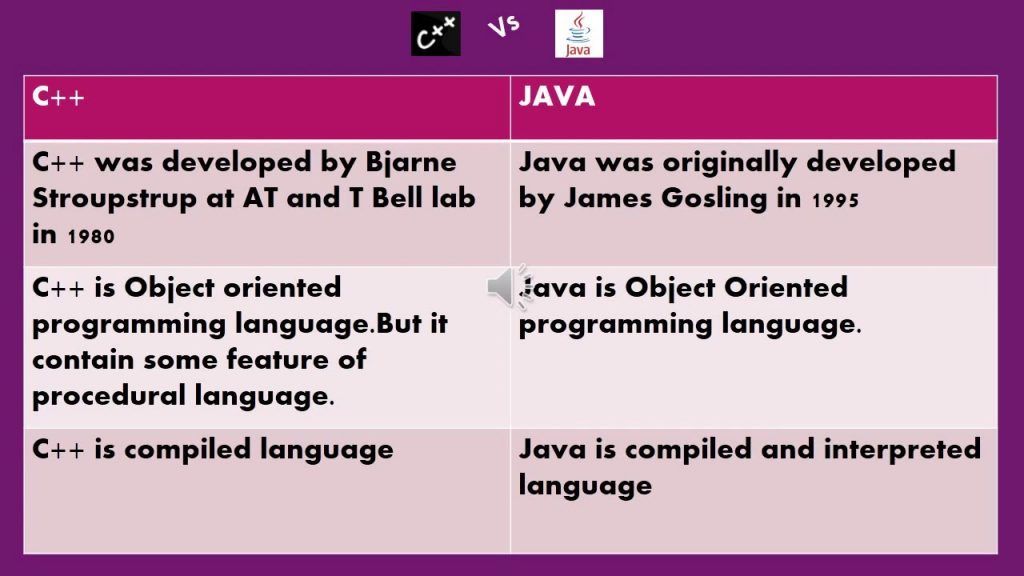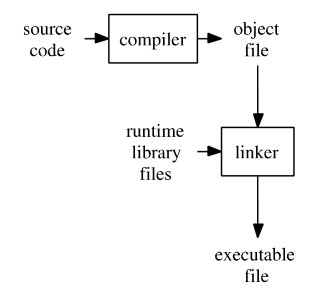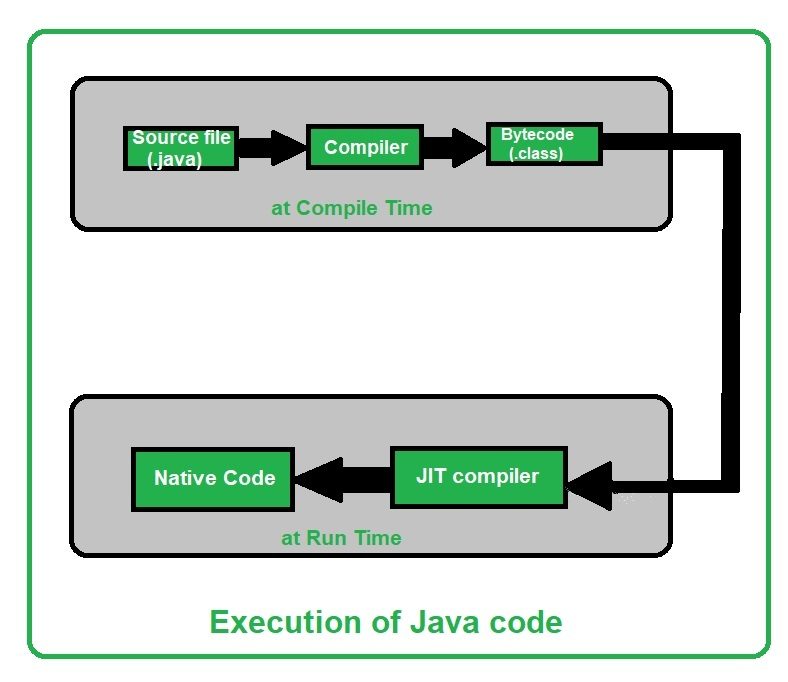
C++ vs Java | Difference You Should Know
Last updated on 07th Dec 2021, Blog, General
The C++ compiler compiles and transforms the source code into machine code. That’s why c++ is more rapid than Java but not platform-independent.
- Introduction to C++ vs Java Programming Language
- Tools in C++ vs Java
- Powerful features of C ++ vc Java
- Road to C++
- What is a method in Java?
- Syntax for C ++ vs Java
- How the c ++ vs Java system works
- Benefits to C++ vs Java
- Conclusion C++ vs Java
- C ++ is a standard purpose programming language that is developed as a C-language enhancement to incorporate an object-focused paradigm. It is an important and integrated language
- C ++ is a medium-level language, which offers the advantage of low-level editing (drivers, bundles) and even advanced applications (games, GUI, desktop applications etc.). The basic syntax and structure of your code for both C and C ++ are the same.
- JAVA was Created by James Gosling in 1991. Simple programming language. Java makes typing, compiling, and proofreading easy. It helps to re-create usable code with modular programs.
- The standard programming language intended for developers to write if it works wherever compiled Java code can work in all forums that support Java. Java applications are integrated into bytecode which can be used on any Java Virtual Machine. Java syntax is similar to c / c ++.
Introduction to C++ vs Java Programming Language:
For C++:
For Java:
Tools in C++ vs Java:
Tools used in C++:
1. Windows Sysinternals
2. Wireshark
3. Visual Assistance
4. ReSharper C ++
Tools used in Java:
JDK is a tool for writing applications with Java Applets. Java Development Kit integrates Java Runtime Environment, Java, and Java APIs. Includes Java program development tools, debugging, and tracking. JDK installs personal JVM and a few other resources to complete Java application development.
NetBeans is an open source java tool used to develop applications such as the web, mobile, desktop. NetBeans IDE is known as the official IDE version of Java 8.
Difference between c++ and java:

Powerful features of C ++ vc Java:
Features of C++:
1. Object Oriented Programming
Unlike C, the process language, C ++ is an object-oriented programming language (OOP). OOP helps to plan and maintain the system efficiently. Improves code clarity, code readability, troubleshooting and makes it easy to install conversions without significant redesign. In addition, OOP uses the use of materials to generate real-time problems based on five solid assumptions.
a. Data Release
If we were to consider a mechanism similar to the metamorphosis process, data extraction could be considered a cocoon. The purpose is to conceal non-essential information from the end user. The end user does not have to worry about internal data code changes or the method used to get it. The only data required for the operation of the system is confidential to the user, without any complicated, internal details.
b. Data Entry
If data extraction is objective, data aggregation is a way to achieve it. Through encapsulation, relevant data and its methods and associated functions are grouped together into a special block.
c. Hiding Data
Although used in the same way as data encapsulation, there are important differences. Data entry is about changing the focus on important data elements. In contrast, data encryption aims to protect the code of a particular program by protecting data from unauthorized access.
d. Ifa
Inheritance refers to the creation of a created child class (based class), gaining the characteristics and functions of the parent class (or foundation class). Asset ensures reuse of code. In other words, if the code needs to be upgraded, there is no need to rewrite the code from scratch. This helps to reduce the reuse of the system and facilitates the easy transfer / duplication / copy of properties from one category to another.
e. Polymorphism
Etymologically, a polymorphism can be divided into ‘poly’ (meaning ‘plural’) and ‘morphism’ (meaning, ‘forms’). Thus, polymorphism facilitates dynamic planning by displaying data in more than one form. This is often used as a user overload or as a workload. Operators and functions can be used with as many items as needed.
2. Independent Machine
Here, automation (or portability) refers to the ability to transfer commands from one workplace to another. C ++ uses the WORA policy (Write Once, Run Anywhere). For example, if you write a program on Microsoft Windows, and for some reason, you have to switch to LINUX, your original program code will work the same way. However, C ++ does not stand alone in one place. This means that the compiler will generate an OS-based .exe file, which can be used on different operating systems.
3. Easy
C ++ is easy to use. It offers a systematic and comprehensive syntax model that mirrors C. In fact, C ++ is popularly known as “C in categories”. C ++ provides a way to go up, as any project development can be redesigned into units and components that make sense. Additionally, it offers a rich set of built-in library functions and a wide variety of data types.
4. Intermediate Planning Language
As a medium level language, it supports your features in both the low level (machine level) and the high level language. It is relatively secretive and closely related to human and understandable language, that is, English.
5. Based on Compiler
C ++ is designed to be an integrated language. This means that it is usually translated into a machine language that the program can understand directly. The resulting system is much more efficient and faster than PYTHON or JAVA, based on the interpreter.
6. Distributed Powerful Memory
Memory in C ++ can be divided into two parts – stack and bulk. Stack means the allocated memory of the variables announced within the function. In contrast, bulk refers to unused memory that can be randomly assigned. For example, if you do not know the memory requirement for storing information on defined variables, the memory size may be determined automatically during operation. This is accomplished using a special operator called a new operator, which returns the address of the allocated space. If necessary, you can use the delete operator to split the memory.
- The concept of Clear Identifiers
- Storage classes
- Preprocessors and header files
- Multiple Inheritance
- Operator Upload
- Goto Statements
- In addition to the removal of these confusing and vague ideas, there is the provision of Automatic Garbage Collection, where there is no need to remove items that are not explicitly addressed.
- Java is “portable” and refers to the SE (Standard Edition) version. The effect actually stems from the neutrality of the structures.
- In C / C ++, source code may work slightly differently on different hardware, but Java makes it easier. You can use Java bytecode on any hardware with compliant JVM that can convert bytecode according to that particular machine.
- In Java, the size of the old data types is mechanically independent, based on the C / C ++ status. Therefore, these features make Java applications portable between different platforms such as Windows, Unix, Solaris, and Mac.
- In addition, any changes and updates made to the operating systems, processors and system resources will not force any changes to Java applications.
- This buzzword means that a program written in one place or OS is independent of other domains or areas and can work on any other Operating System without having to re-install it.
- In other words, it is based on the ‘Write then run-anywhere’ (WORA) or ‘Write-run-everywhere’ approach (WUBE).
- Byte-code does not depend on any machine format and Java Virtual Machine (JVM) can easily translate bytecode into machine-specific code.
- This feature is very useful when building applets or downloading apps online.
- In addition, these applications need to work on different machines, so this feature seems to be very important in this case.
- Next in the Java features article, we will discuss the OOP feature. Java strongly supports the concept of Object-Oriented Programming because it is called pure object language.
- Java supports major Focused Editing features such as Encapsulation, Abstraction, and Asset.
- Almost everything in Java is a thing. All programs and data reside within objects and classes. Java model for ‘objects’ rather than ‘processes’. Java comes with an expanded set of classes organized by packages.
- For example, we can’t upgrade Java applications without using a classroom. This shows that Java is strictly enforcing the Encapsulation policy.
- Java is robust as it manages to process time errors, supports automatic garbage collection and separate management, and avoids explicit identifier concepts.
- Java has a robust memory control system. It helps in debugging as it checks the code between the two integration and operation time.
- Java is a garbage collection language – JVM automatically removes memory barriers and editors do not have to worry about deleting memory by hand as happens in C / C ++.
- Java also provides a separate management concept that identifies operating time errors and eliminates them.
- In Java, any operating time error detected by JVM never goes directly to the underlying system but disconnects the system immediately, preventing it from causing any damage to the sub-system.
- Security is an important issue for any programming language as there is a threat of malicious activity and viruses. Java supports accessibility modifiers to test memory access and ensure that viruses do not include the applet.
- Java is a much safer language compared to C / C ++, as it does not allow the editor to make references explicitly. So in Java, we can’t access certain variables if we do not start them correctly.
- Apps run on a virtual sandbox – A unique feature that allows users to run their apps without touching the underlying system.
- Contains a bytecode authentication checker for code fragments of any illegal code that infringes access.
Features of Java:
Here are the advanced features of the Java program for details:
1. Simple and Standard
It removes complexity because it does not use the complex and complex features of other languages such as C and C ++, which are as follows:
Java is common because:
It has a base for common languages like C and C ++ and contains many features of these languages.
Removes obstacles, complexities and confusing C / C ++. So if you have good knowledge of C / C ++, you will find Java standard and easy to understand.
2. Compiled and Translated
Generally, computer language can be compiled or translated. Java combines the power of Integrated Languages with Translated Language Variations. Java compiler (javac) integrates java source code into bytecode. Java Virtual Machine (JVM) then uses this bytecode which is usable for most applications and is portable.
3. Independent Platform
A very important feature of Java is that it provides platform autonomy that leads to a portable environment, ultimately becoming its greatest power. Local autonomy means that a system integrated into one machine can be implemented on any machine in the world without change. Java gains domain independence by using the BYTE code concept. Java compilers never convert source code into machine code like a C / C ++ compiler. Instead, it converts the source code into a central code called a byte code and this bypass code is also translated into machine-based form with another software layer called JVM (Java Virtual Machine).
4. It is portable
5. Architectural Neutral
6. Focus on the object
7. It is solid
8. Protect yourself
- Class Ways
- There are two ways to describe class activities:
- Ways are class activities.
- Internal description of the class
- Description of the outer class
- In the following example, we define a function within a classroom, and name it “myMethod”.
- Accessibility Index
- Public
- Private
- Protected
- Return Type
- Road Name
- Parameter List
- Road Body
Road to c ++:
What is a method in Java?
- Let’s break down the following code to better understand it:
- LFor example
- L# enter
- Lusing namespace std;
- Lint main ()
- L{
- Lcout<< "Hello World!";
- Lreplace 0;
- L}
- Live demo
- MyFirstJavaProgram community class
- {
- public static void main (String [] args)
- {
- System.out.println (“Hello World :”);
- }
- }
- Let’s look at how to save files, compile, and run a program. Please follow the following steps –
- Open the brochure and add the code as above.
- Save the file as: MyFirstJavaProgram.java.
- Open the command prompt window and go to the directory where you saved the class. Assume it is C: \.
Syntax for C ++ vs Java:
Syntax for C ++
Syntax for Java
Considering the Java system, it can be defined as a group of objects that interact by pleading for each other’s ways. Now let’s take a brief look at the meaning of category, object, methods, and dynamic contexts.
How the C++ system works:
Each C ++ source file needs to be merged into an object file. Object files are derived from a combination of multi-source files and then linked to a usable, shared library, or static library (the last of which is just archive files). C ++ source files usually contain .cpp, .cxx or .cc.
C++ code execution:

How the java system works:
Java code execution:
Java source code is integrated into bytecode when using the javac compiler. Bytecode is saved to disk with a file extension. When the system is about to run, bytecode is converted, using a just-in-time compiler (JIT) compiler. The result is a machine code that is then inserted into memory and executed.

Why c++ vs Java?
C ++ allows you to have more control over how you use computer resources, so in the right hands, its speed and the ability to use cheap resources should be able to surpass other languages. Due to the functionality of C ++, it is often used to improve game engines, games, and desktop applications.
Java is designed to be easy to use and as a result easier to write, compile, and read, edit than any other programming language. Java is focused on something. Java is independent of one location.
Benefits to C++ vs Java:
Benefits to C++
1. Depression
2. Medium planning language
3. Focus on the object
4. Multi-paradigm planning language
5. Memory Management
Benefits to Java
Java is a target language and is a common purpose programming language that helps to create applications and applications in any field. Java comes with a host of benefits that allow you to stick to it. Let’s talk about the benefits of using the Java programming language.
1. Java is Easy
2. Java is an Object-programming language
3. Java is a protected language
4. Java is cheap
Conclusion C++ vs Java
C ++ has the same advantages as C, but it has additional features. C ++ has a learning curve that makes it easy for the beginner editor to access. Larger apps should not be labeled C ++, but apps with smaller to medium size can be labeled C ++ for extra speed and scaling.
Java offers a real opportunity for many programs to be written in a secure language. Extends Java with a parametric polymorphism machine, which allows for the definition and use of common abbreviations. The paper offers a complete design for extended language.
